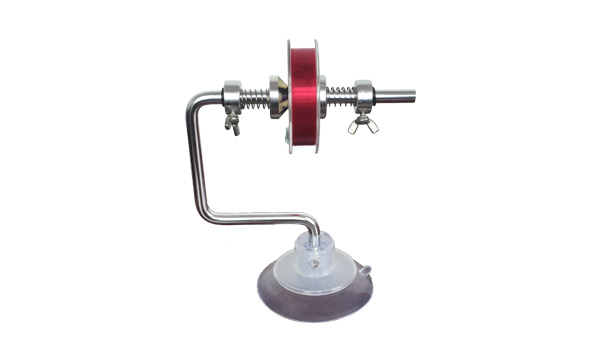

1. What is a Fishing Line Spooler? A Fishing Lin […]
A Fishing Line Spooler is a tool specifically designed to help anglers quickly and easily spool fishing line onto their rods. It uses a series of mechanical parts or an electric motor to make the spooling process more precise and efficient. Typically, a Fishing Line Spooler features a stabilizing stand to hold the rod and line spool, and it allows for the adjustment of tension and spooling speed, preventing issues such as tangling or knotting.
These tools come in various models, ranging from manual spoolers to electric spoolers. Manual models typically require the angler to rotate a handle to spool the line, while electric models automate the process, making them ideal for those who require a more efficient spooling solution.
Whether manual or electric, the basic principle behind a Fishing Line Spooler is the same. The tool’s core function is to rotate the line spool or spool holder, ensuring that the fishing line is evenly wound onto the rod while maintaining proper tension to avoid loose or tight winding.

Manual Spooling refers to the traditional method of spooling fishing line by hand, where the angler manually winds the line onto the rod. Although this method is simple and cost-effective, it comes with some potential drawbacks, especially in terms of efficiency and accuracy.
In manual spooling, the process typically involves securing one end of the fishing line to the rod and then using the hands to pull and wind the line around the rod’s spool. During this process, the angler must adjust the tension of the line by feel, ensuring that it’s neither too loose nor too tight.
Manual spooling is intuitive and straightforward, but without careful attention, it can lead to uneven winding, tangling, or poor tension, which can affect the fishing experience.
One of the biggest advantages of using a Fishing Line Spooler is the significant boost in efficiency. When you need to spool a large amount of line quickly, or when you frequently change lines, a spooler will save you a considerable amount of time. Whether manual or electric, these tools ensure that the line is wound evenly, eliminating the need for repetitive hand movements.
With a Fishing Line Spooler, the line’s tension can be adjusted, helping to prevent tangles and knots. Too loose a tension may cause the line to spool unevenly, while too tight a tension could lead to breakage. A spooler can precisely control the tension, ensuring smooth operation and a perfect spool.
Manual spooling often requires repetitive hand movements and considerable effort, leading to hand fatigue, especially during long spooling sessions. A Fishing Line Spooler helps reduce this physical strain. Electric spoolers, in particular, can automate the entire process, significantly easing the load for anglers.
High-quality Fishing Line Spoolers can be quite expensive, especially electric models. These spoolers can cost upwards of $100 or more, which might be a significant investment for anglers who only fish occasionally.
Fishing Line Spoolers, especially larger models, can take up a fair amount of storage space. For anglers who don’t have much storage room, or those who prefer portability, a spooler might feel like an impractical tool.
Fishing Line Spoolers, particularly electric models, require periodic maintenance. You may need to replace batteries or perform technical maintenance to keep the machine in good working order. This can add extra time and cost to your fishing routine.
Manual spooling is incredibly cost-effective. It requires little more than a rod and a spool of fishing line, with no need for additional equipment. Even if you purchase a basic manual spooler, the cost is still minimal compared to an electric model.
Manual spooling doesn’t require electricity or bulky equipment, making it lightweight and easy to carry. Whether you’re fishing by the lake or hiking to a remote spot, manual spooling tools are portable and easy to use.
Manual spooling is straightforward and intuitive. You don’t need complex settings or technical skills to get started. Whether you’re a beginner or a seasoned angler, manual spooling is a simple process that doesn’t require much setup or learning.
The biggest drawback of manual spooling is its slower pace. It takes longer to spool a line by hand, especially if you’re changing lines frequently or dealing with large amounts of fishing line. This can be frustrating for anglers who need to spool their rods quickly.
Because manual spooling relies on feel, it’s easy to make mistakes, such as winding the line unevenly or using inconsistent tension. These issues can lead to tangled lines, broken lines, or ineffective spooling that will impact your fishing experience.
Long hours of manual spooling can cause hand fatigue, particularly if you are winding a lot of line or doing it repeatedly. For anglers who plan to fish for extended periods, this can become uncomfortable and tiresome.
Choosing between a Fishing Line Spooler and manual spooling depends largely on your personal needs, budget, and how often you fish.
If you fish occasionally and don’t mind spending some time spooling your lines, then manual spooling will likely be sufficient. It’s affordable, simple to use, and doesn’t require additional equipment. For casual fishing, the speed and efficiency of a spooler won’t be as critical, so manual spooling will meet your needs.
If you’re a professional angler or if you fish regularly and need to change fishing lines frequently, a Fishing Line Spooler is a worthwhile investment. It can save you a lot of time, reduce tangling, and maintain consistent line tension, which is crucial for ensuring your fishing performance is optimal.
Electric spoolers, in particular, can automate the process, making them ideal for anglers who need to spool multiple rods in a short time. For those who require efficiency and convenience, a fishing line spooler is the best choice.